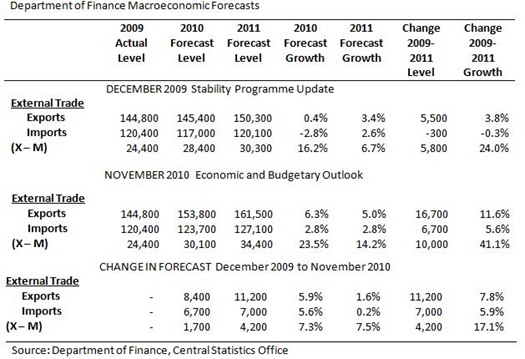The new growth projections from the DoF are worth a little more study. It is clear they have revised down their overall growth forecasts. Here we make a comparison to the forecasts made in the December 2009 Stability Programme Update (Table 4) and the November 2010 Economic and Budgetary Outlook (Table 2).
The listed figures for 2009 are taken from the CSO. The two DoF documents provide forecast growth rates of the “components of real GDP”. The forecast levels for 2010 and 2011 are based on the actual outturns from the CSO and the forecast real growth rates from the DoF. We can use this to compare the changes in the DoF forecasts from December 2009 to those made this week.
Back in December 2009, the DoF forecast that over the two years 2010 and 2011 the domestic economy would shrink by 3.8% in real terms. The November 2010 forecasts predict a total deterioration in the domestic economy in these two years of 6.9%. This is substantially worse.
For the annual forecasts made for consumption, investment and government expenditures for the years 2010 and 2011 we can see that the Department has downgraded five of the six growth forecasts. The only predicted improvement is in household consumption expenditure in 2010 which previously was expected to fall by 3.0% but this has been tempered to a fall of ‘only’ 1.7%. All other forecasts have been downgraded.
This is particularly through of investment expenditure in 2011. The previous forecast increase of 4.5% has been completely reversed to a continued decrease of 6.0%. This change alone counts for more than half of the increased deterioration forecast for the domestic economy. The overall picture painted of the domestic economy is extremely bleak.
What changes have been made to the trade components of GDP?
And, suddenly the future looks so much brighter. The forecasts for exports, in particular, and imports all show increases. The forecast export growth in 2010 jumps from a stagnant 0.4% to a rampant 6.3%. For 2011 the forecast improves from 3.4% to 5.0% export growth. The forecast increase in imports for 2010 is from a decrease of –2.8% to an increase of 2.8%. Very little change is seen in 2011 imports.
The net effect of these changes is that the contribution of trade to GDP is forecast to increase from €24.4 billion in 2009 to €34.4 billion in 2011. This would have a huge positive effect on the GDP growth rate, virtually cancelling out the drag the domestic economy places in the growth rate.
[Aside: I’m not sure whether it is coincidence or not but the forecast further deterioration of the contribution of the domestic economy to GDP of €4.2 billion is almost perfectly offset by the forecast further improvement in the contribution of trade the GDP of €4.2 billion. I sure hope this is a coincidence.]
For the period 2010-2011 the DoF now forecast that exports will increase by €16.7 billion with an accompanying increase in imports of €6.7 billion. This raises a number of concerns.
First as we have pointed out our exports are dominated by a few sectors. Nearly 60% of our merchandise exports come from chemicals with half of this coming from the pharmaceutical exports alone. Of our service exports, nearly 40% is derived from the export of computer services. These high-value sectors have the capability of skewing our exports figures but large increases in the value of exports may not be accompanied by significant increases in employment.
Second, it is hard to imagine how we can increase exports by €16.7 billion and only have an accompanying increase in imports of €6.7 billion. The Information Note states that “imports are projected to increase in line with final demand”. Only a portion of Irish imports are based on domestic demand. This is apparent when we note that imports in 2009 were €120 billion and while consumption was €84 billion.
A lot of our imports aren’t used for consumption, but for rather production and a great proportion of those are used in the export sector. A fairly crude regression of the first differences of imports on the first differences of consumption and exports on quarterly data from 1997Q1 to 2010Q2 using seasonally adjusted constant price data can be seen here.
For example, much of our exports are in the pharmaceutical sector that are based on the processing of compounds and ingredients that are imported. Also, because of a historical lack of R&D in Ireland the patents and copyrights for many of the products which form the bulk of our exports (chemicals and computer services/software) are held abroad. Any increase in exports in these sectors requires a proportionate increase in imports through royalty payments.
It is likely that the €16 billion would require somewhere in the region of an extra €12 billion in imports. This growth in imports would wipe out the tentative positive growth forecast by the DoF and see GDP continue to fall over the next two years.
Increases in exports (and less than proportionate increases in imports), is the factor that is holding the positive DoF forecasts together. The forecast increases in exports may come about, but because of the distribution of our exports they are unlikely to have much of an impact on our unemployment. It does appear that the DoF is aware of this as, although they have forecast positive GDP growth for 2010 (+0.25%) and 2011 (+1.75%), they have forecast a further contraction in employment in 2010 (-4.00%) and 2011 (-0.25%).
Placing all our eggs in the export basket may appear to help us reach the 3% GGD target by 2014 but this will primarily be achieved through an increase in denominator in the debt/GDP ratio. The prospects for the domestic economy remain bleak.
Tweet




No comments:
Post a Comment